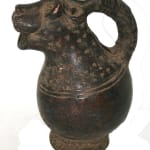Grasslands Terracotta Vessel with an Animal Head Spout, 20th Century CE
Terracotta
MT.299 (LSO)
Further images
This is a gourd-shaped vessel with an extremely unorthodox upper half and spout in the form of an animal head and shoulders. It sits upon a small pedestal base with...
This is a gourd-shaped vessel with an extremely unorthodox upper half and spout in the form of an animal head and shoulders. It sits upon a small pedestal base with incised decoration. The two halves of the vessel are separated by a double incised line; the lower half is plain, the upper decorated with stippling. The body and the head are also connected by a circular cross-section loop handle. The face is made up of double loops enclosing the eyes, with a whiskered snout, a snub nose and an open mouth for pouring liquids from the body of the vessel.
It is somewhat mysterious as it is the first such piece that we have seen. The form is non-diagnostic, and could belong to many West African groups. The Mangbetu and the Dakakari are renowned for their anthropomorphic vessels but less for zoomorphic versions. The Dogon and the Bamana excel at representations of horses but not rather more humorous pieces such as this. The animal itself is also something of a mystery, displaying as it does characteristics of cats, dogs and monkeys. It is can be assumed to be the latter, it may have been madeby the Baule, who have a major preoccupation with monkeys as evidenced by the Gbreke shrine figures. However, these are typically highly stylised and extremely threatening in appearance, inlike this rather quaint representation. The Yoruba have been known to also produce such pieces – there is one such in the Barakat Collection – and it is to this tribe that the current piece has been attributed.
Its function is bound to have been something more than secular, presumably some form of ritual device for the application of libations or distributing wine etc. Whatever its function, this is an attractive and amusing piece of African art.
It is somewhat mysterious as it is the first such piece that we have seen. The form is non-diagnostic, and could belong to many West African groups. The Mangbetu and the Dakakari are renowned for their anthropomorphic vessels but less for zoomorphic versions. The Dogon and the Bamana excel at representations of horses but not rather more humorous pieces such as this. The animal itself is also something of a mystery, displaying as it does characteristics of cats, dogs and monkeys. It is can be assumed to be the latter, it may have been madeby the Baule, who have a major preoccupation with monkeys as evidenced by the Gbreke shrine figures. However, these are typically highly stylised and extremely threatening in appearance, inlike this rather quaint representation. The Yoruba have been known to also produce such pieces – there is one such in the Barakat Collection – and it is to this tribe that the current piece has been attributed.
Its function is bound to have been something more than secular, presumably some form of ritual device for the application of libations or distributing wine etc. Whatever its function, this is an attractive and amusing piece of African art.









